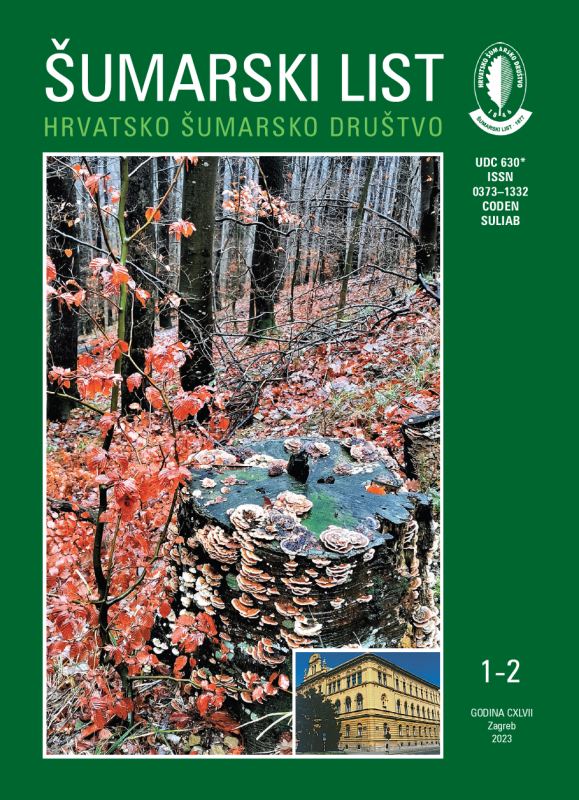
broj: 1-2/2023
pdf (8,7 MB) |
|
||||||||||||||
| RIJEČ UREDNIŠTVA | ||
| Uredništvo | ||
| How is the leased forestland used? pdf HR EN | 5 | |
| IZVORNI ZNANSTVENI ČLANCI | ||
| Ida Katičić Bogdan, Višnja Jurkić, Ivana Brlek, Marko Bačurin, Saša Bogdan | UDK 630* 165.+181.8 (001) https://doi.org/10.31298/sl.147.1-2.1 | |
| Genetic diversity of reproductive and phenological traits and their interrelationships in a clonal seed orchard of Wild Cherry (Prunus avium L.) pdf HR EN | 7 | |
| Krunoslav Teslak, Marijana Andabaka, Andrea Mertini, Karlo Beljan, Mislav Vedriš | UDK 630* 622+631 (001) https://doi.org/10.31298/sl.147.1-2.2 | |
| Choice of adaptive forest management model based on long-term projection in dinaric fir-beech stands pdf HR EN | 21 | |
| Milica Marčeta, Ljiljana Keča, Stjepan Posavec, Sreten Jelić | UDK 630*901 (001) https://doi.org./10.31298/sl.147.1-2.3 | |
| Socio-economic characteristics of forestry companies in the Republic of Serbia pdf HR EN | 39 | |
| Mirzeta Memišević Hodžić, Dalibor Ballian | UDK 630* 164 (001) https://doi.org/10.31298/sl.147.1-2.4 | |
| Variability of leaf morphological traits of european black poplar and hybrid black poplars in the clone archive in Žepče pdf HR EN | 53 | |
| Mehmet Kalkan, Mustafa Yilmaz, Rasim Alper Oral | UDK 630* 164 (001) https://doi.org/10.31298/sl.147.1-2.5 | |
| The morphological and chemical variability of Turkish Hazel (Corylus colurna L.) fruits in Turkey pdf HR EN | 65 | |
| Abstract Turkish hazel (Corylus colurna L.) is naturally distributed in southeast Europe, Anatolia, the Caucasus and Western Himalayas. In Turkey, there are many isolated populations in the Black Sea, Marmara, Aegean, and Central Anatolian Regions. Many of the small populations in Turkey are endangered. In this study, the morphological and chemical characteristics of Turkish hazelnut fruits collected from seven populations were researched. In this regard, considering the morphological characteristics of fruits and kernels, significant differences were observed between the populations. Length, width, thickness, and weight averages were 15.98 mm, 15.38 mm, 12.00 mm and 1.4651 g in the fruits, and 13.03 mm, 11.22 mm, 7.64 mm and 0.5047 g in the kernels, respectively. The average shell thickness was 1.92 mm, shell weight was 0.9604 g, and kernel ratio was 35.16%. Statistically significant differences were found out between the populations whose chemical contents were analyzed. As a result of the analysis, the average fat content, protein, starch, and ash were 64.1%, 15.9%, 10.2 g, and 2.5%, respectively. According to the averages in the obtained fatty acids, the main fatty acids were oleic acid (79.53%), linoleic acid (11.34%), palmitic acid (5.68%), and stearic acid (2.03%), while the rest of other oils were found in trace amounts. Overall, our results suggest that the information relating to morphological and chemical characteristics of Turkish hazelnut can be useful for discriminating among populations. Key words: hazel; hazelnut; fruits; morphometric analysis; chemical analysis; hazelnut oil | ||
| PREGLEDNI ČLANCI | ||
| Hubert Codrow, Anna Wierzbicka, Maciej Skorupski | UDK 630* 156 https://doi.org/10.31298/sl.147.1-2.6 | |
| Factors shaping teenagers and young adults’ approach to hunting : a review of the literature pdf HR EN | 75 | |


